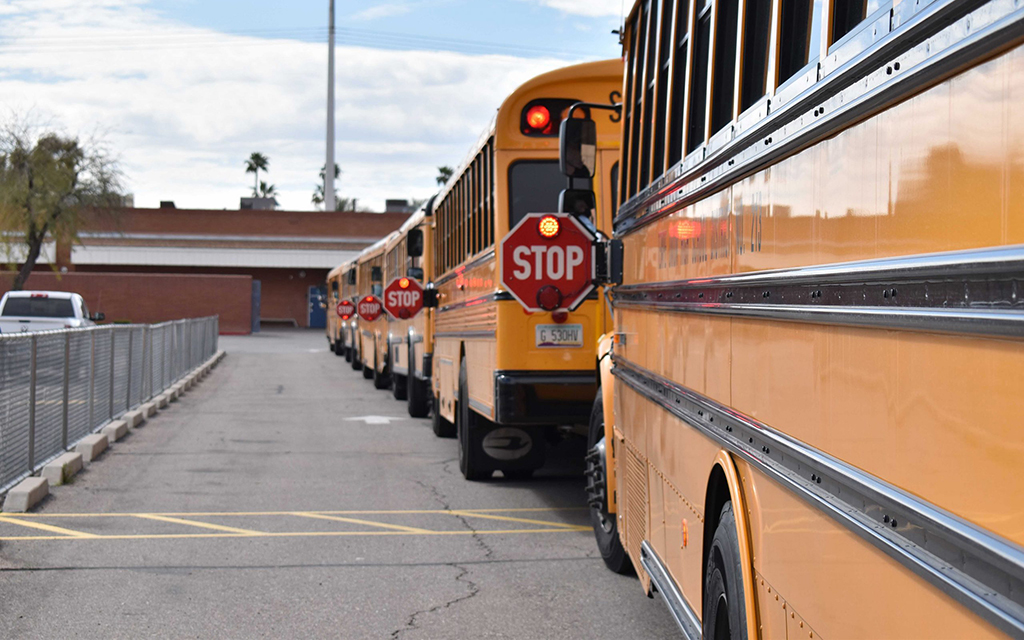
The Arizona House and Senate both voted this week to override the aggregate expenditure limit, a constitutional amendment that limits public school spending based on a formula from 1980. (File photo by Alex Gould/Cronkite News)
PHOENIX – The Arizona Senate and House have overridden the aggregate expenditure limit for the second year in a row, which will allow school districts to spend their Legislature-appropriated funds. Gov. Katie Hobbs said the action was “long overdue” and called the limit from 1980 an “archaic cap on school funding.”
The Senate voted Wednesday, 23-7, with all 14 Senate Democrats and 9 of the 16 Republicans, to override the cap on school district budgets that prevents them from using their full budgets. The House passed the override Tuesday, 46-14, with all 29 House Democrats and 17 of the 31 Republicans. Both chambers met the two-thirds majority needed to lift the cap.
The aggregate expenditure limit is a 1980 voter-approved constitutional amendment that must be overridden by March 1 in years the cap is exceeded, or school districts need to make budget cuts.
This year, the school districts would have needed to cut nearly $1.4 billion by April 1 without the override, according to Chuck Essigs, director of governmental relations for the Arizona Association of School Business Officials.
Rep. David Cook, R-Globe, said it’s legislators’ “constitutional duty” to make sure any department or agency is allowed to operate within the budget they were provided by the Legislature.
Rep. Jennifer Pawlik, D-Chandler, a teacher and the ranking Democrat on the House Education Committee, noted the need for long-term reform in her floor remarks on Tuesday, according to a press release from the Arizona House Democrats. Pawlik represents portions of the southeast Valley.
“We have schools across the state that will have to close their doors or lay off teachers if we don’t pass this cap. It’s absolutely critical,” Pawlik said, according to the release. “It’s perhaps even more critical in the rural areas, where the schools are the largest employers in the community. I’m pleased to hear that some of my colleagues on the other side of the aisle are willing to talk about a long-term fix. I’m sure that’s something we can work on.”
Sen. Justine Wadsack, a Republican whose district includes parts of Pinal and Pima counties, voted against the override and advocated for fiscal transparency.
“I am hoping we can start instituting some of the classroom-first funding, the back-to-basics for student success, the empowering parents through academic transparency, and the parent trust and empowerment in our school systems so that we can move forward and I can feel good about giving more money to the schools,” Wadsack said.
What is the aggregate expenditure limit?
The aggregate expenditure limit for public, non-charter districts changes each year as it is based on changes in the state’s total student population as well as changes in inflation. Because of the variability, districts don’t always reach the cap.
“The calculation is pretty simple,” Essigs said. “It was what the districts spent before the limit went in place in the aggregate in Arizona, increase that by inflation, and increase that by changes in students and that’s the limit going forward.”
The limit is now 40 years old, and although it has grown for inflation and students, what schools do today is vastly different than in 1980, Essigs said. There are more special education students and more vocational technical programs, for example.
The Legislature approved individual school district budgets last session, which exceed the aggregate limit. The only way for school districts to spend the money the Legislature is providing to them, according to Essigs, is if the Legislature overrides the limit each year.
The cap has been overridden in 2007, 2008 and 2022.
Effect on schools
If the Legislature didn’t override the limit, the reduction would come April 1, and each school would need to cut about 17% of its budget with less than three months left in school, Essigs said.
“It essentially puts school districts out of business for three months because they have already spent 75% of the money,” said Christopher Kotterman, director of governmental relations for Arizona School Board Association.
Salary and benefits make up about 80% of school district operating budgets, Kotterman said. Schools would have to have shorter weeks and furlough staff or end the school year early.
“We have been trying to get these legislators to understand,” Kotterman said. “There’s no way you can trim that much expense without impacting daily operations for most districts.”
The aggregate expenditure limit affects more than 800,000 students across the state, according to Ricky Hernández, chief financial officer at Tucson Unified School District.
Hitting the limit would “have a trickle-down effect across every community whether you’re Phoenix or whether you’re Show Low,” Hernández said. “That’s something we should all be concerned about; it’s not just about losing instruction, it’s about losing jobs and your economic standard in every community.”
What schools want to see done
School district advocates want voters to permanently eliminate the aggregate expenditure limit.
“This situation with the AEL just creates unneeded complication with school budgeting. We get the budget done whenever the Legislature gets it done, but now we have to wait until they decide they want to override this limit before we can actually spend all the money appropriated to us,” Kotterman said.
Last year almost 200 school superintendents from across Arizona urged then-Gov. Doug Ducey to call a special session to send the aggregate expenditure limit to voters, which didn’t happen. Voters could also collect signatures to get the initiative on the ballot.
“We need to make an update to this limit that makes it so we’re not going over it every year by just appropriating the money that the state funding formula generates,” Kotterman said. “Literally if you didn’t put a single dollar into schools additionally except for what’s required by statute today, we would still be over the limit next year and the year after that and the year after that.”


